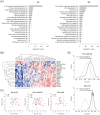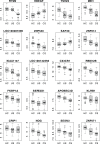Peripheral blood gene expression as a novel genomic biomarker in complicated sarcoidosis
- PMID: 22984568
- PMCID: PMC3440319
- DOI: 10.1371/journal.pone.0044818
Peripheral blood gene expression as a novel genomic biomarker in complicated sarcoidosis
Abstract
Sarcoidosis, a systemic granulomatous syndrome invariably affecting the lung, typically spontaneously remits but in ~20% of cases progresses with severe lung dysfunction or cardiac and neurologic involvement (complicated sarcoidosis). Unfortunately, current biomarkers fail to distinguish patients with remitting (uncomplicated) sarcoidosis from other fibrotic lung disorders, and fail to identify individuals at risk for complicated sarcoidosis. We utilized genome-wide peripheral blood gene expression analysis to identify a 20-gene sarcoidosis biomarker signature distinguishing sarcoidosis (n = 39) from healthy controls (n = 35, 86% classification accuracy) and which served as a molecular signature for complicated sarcoidosis (n = 17). As aberrancies in T cell receptor (TCR) signaling, JAK-STAT (JS) signaling, and cytokine-cytokine receptor (CCR) signaling are implicated in sarcoidosis pathogenesis, a 31-gene signature comprised of T cell signaling pathway genes associated with sarcoidosis (TCR/JS/CCR) was compared to the unbiased 20-gene biomarker signature but proved inferior in prediction accuracy in distinguishing complicated from uncomplicated sarcoidosis. Additional validation strategies included significant association of single nucleotide polymorphisms (SNPs) in signature genes with sarcoidosis susceptibility and severity (unbiased signature genes - CX3CR1, FKBP1A, NOG, RBM12B, SENS3, TSHZ2; T cell/JAK-STAT pathway genes such as AKT3, CBLB, DLG1, IFNG, IL2RA, IL7R, ITK, JUN, MALT1, NFATC2, PLCG1, SPRED1). In summary, this validated peripheral blood molecular gene signature appears to be a valuable biomarker in identifying cases with sarcoidoisis and predicting risk for complicated sarcoidosis.
Conflict of interest statement
Figures



Similar articles
-
Molecular profiling in sarcoidosis.Curr Opin Pulm Med. 2020 Sep;26(5):562-567. doi: 10.1097/MCP.0000000000000716. Curr Opin Pulm Med. 2020. PMID: 32701678 Free PMC article. Review.
-
Identification of Jak-STAT signaling involvement in sarcoidosis severity via a novel microRNA-regulated peripheral blood mononuclear cell gene signature.Sci Rep. 2017 Jun 26;7(1):4237. doi: 10.1038/s41598-017-04109-6. Sci Rep. 2017. PMID: 28652588 Free PMC article.
-
RNA-sequencing Identifies Novel Pathways in Sarcoidosis Monocytes.Sci Rep. 2017 Jun 2;7(1):2720. doi: 10.1038/s41598-017-02941-4. Sci Rep. 2017. PMID: 28577019 Free PMC article.
-
GWAS identifies genetic loci, lifestyle factors and circulating biomarkers that are risk factors for sarcoidosis.Nat Commun. 2025 Mar 12;16(1):2481. doi: 10.1038/s41467-025-57829-z. Nat Commun. 2025. PMID: 40075078 Free PMC article.
-
Search for sarcoidosis candidate genes by integration of data from genomic, transcriptomic and proteomic studies.Med Sci Monit. 2009 Dec;15(12):SR22-8. Med Sci Monit. 2009. PMID: 19946248 Review.
Cited by
-
Molecular profiling in sarcoidosis.Curr Opin Pulm Med. 2020 Sep;26(5):562-567. doi: 10.1097/MCP.0000000000000716. Curr Opin Pulm Med. 2020. PMID: 32701678 Free PMC article. Review.
-
Overexpression of IL-17RC associated with ocular sarcoidosis.J Transl Med. 2014 May 31;12:152. doi: 10.1186/1479-5876-12-152. J Transl Med. 2014. PMID: 24885153 Free PMC article.
-
Evaluation of gene expression classification studies: factors associated with classification performance.PLoS One. 2014 Apr 25;9(4):e96063. doi: 10.1371/journal.pone.0096063. eCollection 2014. PLoS One. 2014. PMID: 24770439 Free PMC article.
-
Refractory pulmonary sarcoidosis - proposal of a definition and recommendations for the diagnostic and therapeutic approach.Clin Pulm Med. 2016 Mar;23(2):67-75. doi: 10.1097/CPM.0000000000000136. Clin Pulm Med. 2016. PMID: 26973429 Free PMC article.
-
Solving the Conundrum: Immunogenetics of Sarcoidosis.Am J Respir Crit Care Med. 2015 Sep 15;192(6):652-4. doi: 10.1164/rccm.201506-1235ED. Am J Respir Crit Care Med. 2015. PMID: 26371809 Free PMC article. No abstract available.
References
-
- Iannuzzi MC, Rybicki BA, Teirstein AS (2007) Sarcoidosis. N Engl J Med 357: 2153–2165. - PubMed
-
- Newman LS, Rose CS, Maier LA (1997) Sarcoidosis. N Engl J Med 336: 1224–1234. - PubMed
-
- Nunes H, Freynet O, Naggara N, Soussan M, Weinman P, et al. (2010) Cardiac sarcoidosis. Semin Respir Crit Care Med 31: 428–441. - PubMed
-
- Zajicek JP, Scolding NJ, Foster O, Rovaris M, Evanson J, et al. (1999) Central nervous system sarcoidosis–diagnosis and management. Qjm 92: 103–117. - PubMed
-
- Morgenthau AS, Iannuzzi MC (2011) Recent advances in sarcoidosis. Chest 139: 174–182. - PubMed
Publication types
MeSH terms
Substances
Grants and funding
LinkOut - more resources
Full Text Sources
Other Literature Sources
Medical
Molecular Biology Databases
Research Materials
Miscellaneous

